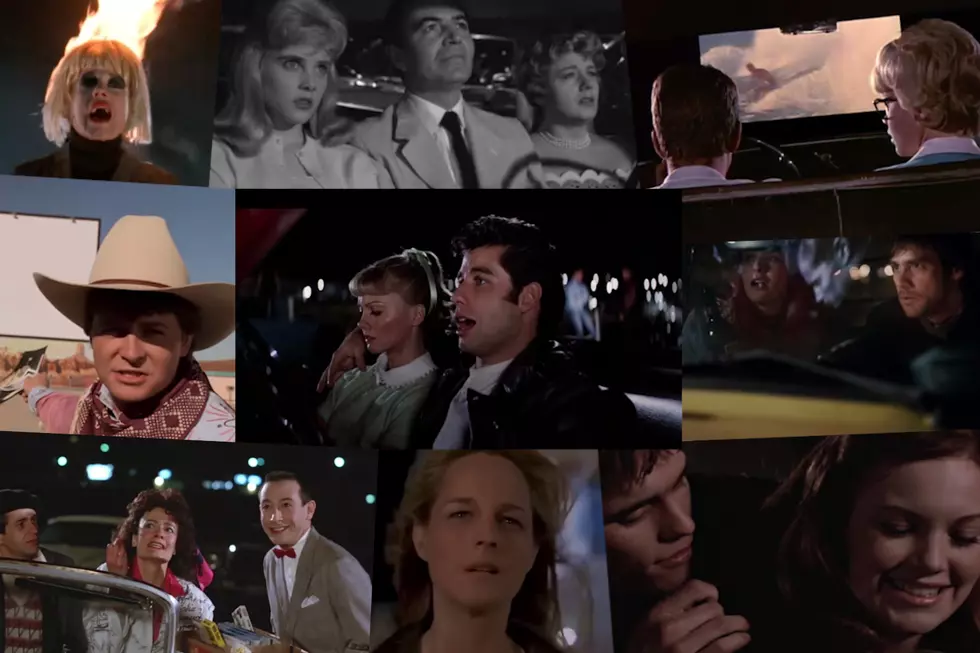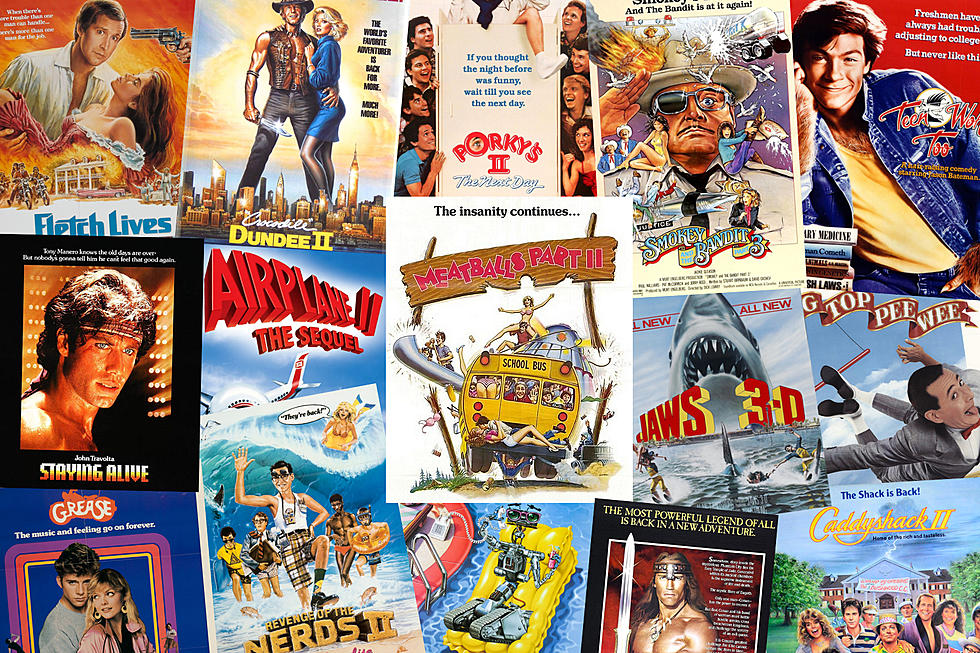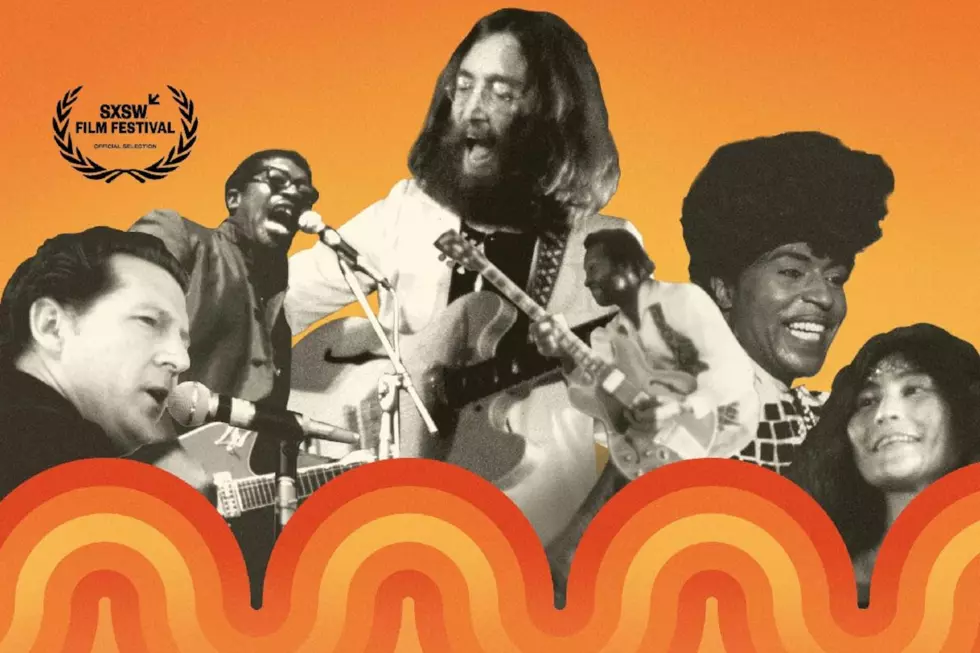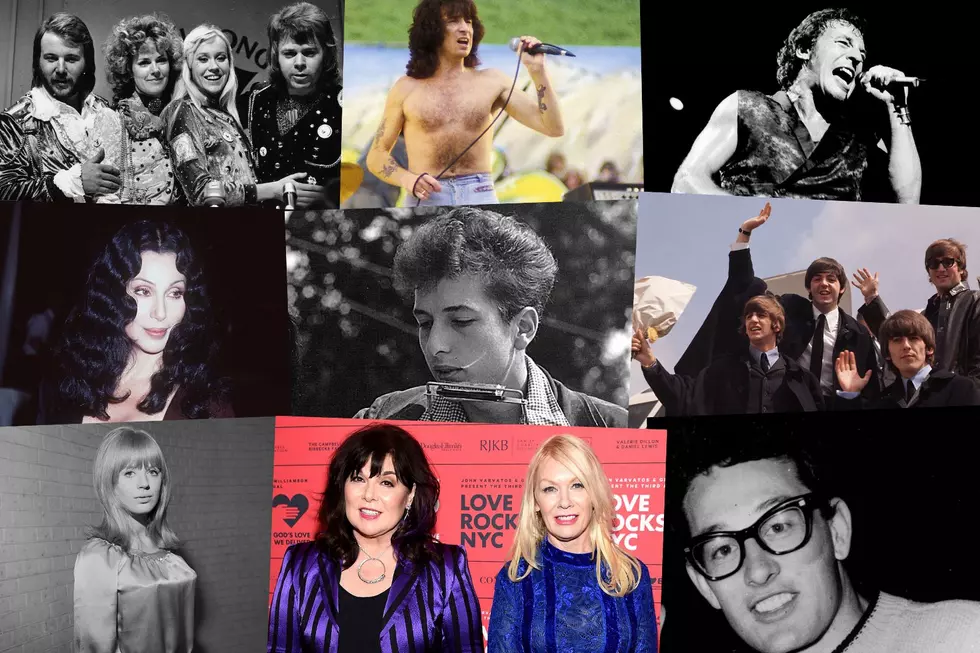
20 Most Memorable Movie Scenes Set at the Drive-In
As technology continues to transform movie watching into an ever-more solitary, even lonely experience, it’s time to take a look back at a time when going to the movies was at its most social. The very first drive-in movie theater opened in New Jersey on June 6, 1933, catering to an America rapidly embracing car and movie culture in equal measure, and throwing Hollywood up onto the biggest possible screen, right out in the open air.
Both communal and intimate, the drive-in experience allowed young lovers an oasis of privacy, with legends of drive-in babies conceived to flickering images half-glimpsed through steamed-up windows. Hardly the place for art films with their complex themes and somber silences, drive-ins became a haven for B-pictures whose exploitation elements and garish thrills catered increasingly to the drive-in crowd out for a rowdy good time. Naturally, the movies themselves started to reflect that drive-in world onscreen, with some of cinema’s most memorable sequences (or even entire movies) set amidst big screen approximations of the very canoodling, popcorn-munching, trunk-stuffing crowds who’d assembled to watch.
Below we run down the 20 Most Memorable Movie Scenes Set at the Drive-In.
'Attack of the Puppet People' (1958)
Give it to famed schlockmeister producer-director Bert I Gordon for both chutzpah and thriftiness here. When traveling salesman John Agar brings his best gal June Kenney to the drive-in for date night, it’s to see Gordon’s 1957 opus The Amazing Colossal Man, about a G.I. whose A-bomb exposure sees him getting really, really big. Gordon, who never saw a human being he didn’t want to change in size one way or another, also gets points for foreshadowing and irony, as it’s ultimately the fate of these two lovebirds to fall afoul of Kenney’s loopy mad scientist boss, who shrinks the duo down to join his menagerie of miniaturized puppet people. (It’s right in the title)
'Lolita' (1962)
Thwarted desire plays out as queasy comedy when James Mason’s Professor Humbert Humbert takes his purported, age-appropriate love interest and her secretly desired underage daughter to the drive-in. James Mason’s Humbert has Sue Lyon’s Lolita just where every sweaty, lustful teenage boy would have her, as he gleefully accepts the panicked clench of Lolita’s hand when Christopher Lee’s terrifying monster appears onscreen in 1957’s The Curse of Frankenstein. Unfortunately for the unsavory professor, he can only live out his fantasy with Lolita’s brash, middle-aged mother Shelley Winters sitting on his other side, Mason’s mixed emotions are a masterful ballet of physical comedy as mother and daughter both clutch at him for comfort.
'That Darn Cat!' (1965)
There’s one great gag in this innocuous and appropriately fluffy live-action Disney movie about a mischievous kitty helping FBI agent Dean Jones and cat-loving local gal Hayley Mills foil a kidnapping. When Jones tails (sorry) the titular Siamese to the local drive-in, his attempts to follow the cat send it fleeing to the theater’s projection booth, where the feline’s swats at a stray moth wind up being projected onto the big screen, turning the surf movie on offer akin to a feline-led Godzilla flick. Toss in some gags about Jones’ pursuit costing a hapless moviegoer a small 1960s fortune in spilled concessions, and you have a Disney-fied take on just what goes on at the drive-in.
'Targets' (1968)
Peter Bogdanovich’s directorial debut posits a changing world where even the towering projected horrors at the drive-in pale next to the modern capacity for senseless violence. A clean-cut, gun-obsessed young Vietnam veteran calmly murders his wife and parents before perching atop a roadside Texas oil storage tank and just as dispassionately picking off motorists—before fleeing to a local drive-in theater to set up his next sniper’s nest. Meanwhile, that same theater is hosting one of the final films of horror icon Byron Orlok (played by horror icon Boris Karloff), who’s grown weary of his movies’ inability to inspire much terror anymore. In the end, it’s a confrontation between the elderly, cane-wielding, old-school British boogeyman and the new breed of real-life American monster that finally decides the fate of a drive-in crowd cowering in their trapped automobiles, with Orlok’s hoary final feature (actually Karloff’s 1963 Gothic horror flick The Terror) playing out impotently in the background.
'Drive-In Massacre' (1976)
Imagine Targets but without Boris Karloff, Peter Bogdanovich or anyone involved with one iota of talent or imagination and you’ve got this bargain basement scrap of drive-in fare that squanders its can’t-miss premise. A maniac is chopping up lovers at the local drive-in with a sword, the stubborn manager inexplicably refuses to close the multiple murder scene, and the frustrated police chase their tails, all leading to an open-ended mystery that warns the actual drive-in audience that a series of similar murders are happening at drive-ins all across America. Whether this inept slice of exploitation scared potential customers away with its ludicrous non-ending or not, it’s virtually forgotten today, the marginal allure of a drive-in screening long since replaced by the soporific prospect of grainy home viewing.
'Drive-In' (1976)
Unlike several others on this list that use the drive-in as a backdrop for terror, this innocuous, little-remembered '70s drive-in flick about horny teens gathering for a night of drinking, debauchery and the occasional inept gang fight traffics in light-hearted, countrified silliness (It’s all right there in the title.) Sure, there are a pair of bumbling thieves plotting to rob the busy Alamo Drive-In, but mainly Drive-In is the sort of rambunctious teen comedy always on the lookout for a fresh setting for its teen heroes to get up to no good. In this case, that’s the opening of a fictional (but period-plausible) low-rent disaster flick, Disaster ’76.
'Grease' (1978)
“Sandy, my darlin’, you hurt me real bad,” says John Travolta’s jilted greaser Danny Zuko during the spoken word break of the song “Alone at a Drive-In” in this '70s classic of 1950’s high school nostalgia. Danny’s not wrong, as we’ve just seen Olivia Newton-John’s prim and proper Sandy slam Danny’s erection in the car door after she rejected his clumsy front-seat pawing. Travolta’s resulting lament for all the klutzy boys who mistakenly imagined that a trip to the local drive-in constituted consent is an affectionately tone-deaf ballad of teen male cluelessness, all couched in the language of confused betrayal. As Travolta perches on a lonely swing set (an amenity of some of your more family-courting drive-in establishments), Danny’s moony closing cry of, “Why? Oh Sandy,” as the ignored movie screen flickers in the background marks yet another instance of a horny teenage boy missing the point.
'The Outsiders' (1983)
In Francis Ford Coppola’s elegiac adaptation of S.E. Hinton’s novel, the local drive-in is lovingly recreated as the place where the rambunctious and class-divided teens of 1965 Tulsa, Oklahoma mix. Greasers Matt Dillon, C. Thomas Howell and Ralph Macchio sneak in under the fence for lack of both money and a car, while Diane Lane and Michelle Meyrink’s rich girls flee the flashy sedan of their handsy boyfriends, with both groups winding up uneasily sharing the drive-in’s stand of dusty outdoor seats. Dillon’s Dallas and Lane’s Cherry immediately are at each other’s throats thanks to Dallas’ tough guy come-ons, while Howell’s watchful and sensitive Ponyboy can only mount a feeble objection to his older idol’s boorish harassment. Meanwhile, the then-current Beach Blanket Bingo spools out on the big screen, the innocuous, squeaky-clean antics of its overaged “teen” cast seeming to emerge from another universe.
'Christine' (1983)
Always a hotbed of car-swapping teen jealousy, the drive-in becomes the setting for a most unlikely love triangle/attempted murder scene in John Carpenter’s adaptation of Stephen King’s novel about the titular demonic automobile. As increasingly obsessed/possessed nerd Keith Gordon berates new girlfriend Alexandra Paul for complaining about all the attention he’s paying to his lovingly restored 1958 Plymouth Fury, the torrential rain obscures their intended drive-in date movie, Thank God It’s Friday. Underwhelming disco drama is the least of the couple’s worries, however, as a concession stand burger is soon lodged in Paul’s windpipe, with the frantic Gordon trapped outside by the sentient (and jealous) car’s suspiciously locked doors. The tragedy is averted thanks to a watchful fellow attendee’s Heimlich maneuver, but not before Christine lets her human lover know just who’s got the real power at the drive-in.
'Pee-wee’s Big Adventure' (1985)
After successfully chasing his purloined bicycle across the country, Paul Reubens’ Pee-wee celebrates his triumph at the drive-in. Gathering together everyone he’s met through his madcap pursuit in one celebratory cinematic bash is a perfect encapsulation of Pee-wee’s oddball charm, especially since the last leg of his journey took Pee-Wee through Hollywood backlots, landing his life story an admittedly highly fictionalized big screen adaptation. With a suave James Brolin and jumpsuit-wearing Morgan Fairchild essaying the roles of Reubens’ bow-tied weirdo protagonist and Elizabeth Daily’s Pee-wee-smitten Dottie in a slice of James Bond-ian exploitation silliness on the big outdoor screen, Pee-wee himself greets all his gathered new friends with armloads of concessions and a knowing giggle.
'Dead End Drive-In' (1986)
The drive-in’s salacious allure becomes a trap in this grimy slice of post-Mad Max Ozploitation. After a social and economic collapse, teen lovers Crabs and Carmen seek escape at the isolated local desert drive-in, only to slowly realize that the government has turned these outdoor movie oases into internment camps for the disaffected and increasingly dangerous youth. Supplied with ample doses of sex, drugs and exploitation cinema (including at least two other Aussie flicks from this film’s director, Brian Trenchard-Smith) to keep them pacified, the entrapped kids succumb to excess, infighting and racism, just as the powers that be expected, all while the young heroes seek to break out of their movie-saturated prison. A sly riposte to both government repression and easily coopted youthful rebellion, Dead End Drive-In demonstrates how exploitation films, in themselves, are no substitute for an actual revolution.
'Back to the Future Part III' (1990)
Amidst the time-hopping shenanigans of this final installment in the Back to the Future series, Michael J. Fox’s Marty and Christopher Lloyd’s Doc seek out an appropriately flat and deserted stretch of land for their time-traveling DeLorean to hit the requisite 88 mph. Naturally, a daytime-deserted, Old West-themed drive-in provides just the conditions (and 1950’s-insensitive Native American decor) for the task, with Marty obligingly hurtling right at the silent white screen with its apron of rampaging Indian warriors seemingly daring him to plow through them. Why aim a hurtling luxury vehicle directly into a solid drive-in screen? Don’t ask questions, as the flux capacitor does its thing in time for the shocked Marty to find himself face-to-face with some actual 1885 Native American riders on horseback.
'Twister' (1996)
How do you show that your movie’s big bad is badder than anyone else’s? You have it rip right through the giant, sneering face of Jack Nicholson’s Jack Torrance in The Shining. At least that’s the impression left by Jan de Bont’s bombastic disaster flick Twister, as the titular tornado decides to pursue twister-chasers Bill Paxton and Helen Hunt right to the Tornado Alley drive-in where they’d unwisely chosen to take the night off. With Paxton and Hunt sniffing at the gathering storm in practiced alert, it’s only a matter of moments before Nicholson’s climactic rampage through the Overlook Hotel is cut down to size as the cyclonic winds tear the fragile drive-in screen apart just as Torrance is about to announce, “Here’s Johnny!”
'The Cider House Rules' (1996)
In Lasse Hallstrom’s Oscar-winning adaptation of John Irving’s sprawling novel, grown but sheltered orphan Homer Wells (Tobey Maguire) is introduced to the glories of the world outside his Maine orphanage when dishy Candy Kendall takes the boy to the local drive-in. With it being WWII and blackout orders being in place, the theater sits empty, but Homer and Candy still act out the expected teenage rebellion, sharing hand-rolled cigarettes amidst the silent speakers and empty parking spaces. While Homer tells the smitten Candy that he loves the movies, he admits he’s ever only seen only the orphanage’s single, ratty print of King Kong while he looks up at the impossibly huge outdoor screen and no doubt imagines the giant ape projected in all his glory. A later trip to an indoor theater for a date watching 1939’s Wuthering Heights follows, even if Homer has to confess it was no Kong.
'Cecil B. Demented' (2000)
In John Waters’ typically bad-taste homage to bad-taste filmmaking, spoiled Hollywood diva Honey Whitlock (Melanie Griffith) is kidnapped by a low-down, art-obsessed gang of Baltimore filmmakers, led by Stephen Dorff’s maniacal Cecil. After succumbing to Stockholm syndrome during her time in the grimy gang’s clutches (the film is loosely inspired by the kidnapping of Waters’ pal Patricia Hearst), Whitlock ultimately joins in the cinematic revolution, sabotaging a screening of a Patch Adams director’s cut and the filming of a Forrest Gump sequel before winding up at one of the area’s last remaining drive-ins for a showdown with the irate cops. (Waters used Maryland’s still-operational Bengies Drive-in Theatre for his grand finale.) With most of the crew dead or wounded, including Cecil, Whitlock climbs atop the screen and, to the delight of the gathered fans enraptured by her criminal exploits, sets her hair on fire, screaming, “Make good movies or die!” It's an appropriately apocalyptic message from Baltimore’s favorite and most disreputable cinematic son.
'Psycho Beach Party' (2000)
It’s only fitting that this deliriously silly mashup of '60s beach party movie and slasher flick kicks off at the drive-in. Gathered to watch a black-and-white sci-fi flick similar to Attack of the 50 Foot Woman (with a little of The Manster thrown in), the local surf dudes and gals all steam up their car windows, scarf down hot dogs and, in the case of a young Amy Adams and Buffy the Vampire Slayer’s Nicholas Brendon, flirt by awkwardly tongue-mangling ice cream sandwiches at each other. When repressed good girl Lauren Ambrose heads to the concession stand for a wiener, her friend witnesses a slasher cutting a fellow moviegoer’s throat, the ensuing rockabilly theme from all-luchador instrumentalists Los Straitjackets roaring to life and ably hinting at the hybrid comic thrills to come.
'Eternal Sunshine of the Spotless Mind' (2004)
In Michel Gondry’s heartbreaking tale of love and regret (and dubious science), it’s only fitting that one of protagonist Joel Barish’s most cherished memories of his fraught relationship with the mercurial Clementine resides at the drive-in. Or rather, outside of one, as Jim Carrey’s Joel and Kate Winslet’s Clementine park within view of a screen showing the forgotten 1958 creature feature Monster on the Campus, the happy couple providing their own, Mystery Science Theater 3000-style running replacements for the unheard dialogue. As the film’s sci-fi apparatus starts to strip away the scene (and the screen) per Joel’s now-changed wishes, he desperately hustles Clementine out of their parked car after seemingly seizing her back from oblivion.
'The Other Side of the Wind' (2018)
The drive-in is the final destination of the roving, all-night party surrounding the 70th birthday of maverick film director Jake Hannaford (John Huston), whose latest film has been left unfinished after the departure of his lead actor. This was also the fate of this typically ambitious and long-gestating unfinished film by maverick American screen legend Orson Welles, which, after some 48 years in various states of disassembly and chaos, was cobbled into something resembling a finished film in 2018. The resulting picture is a fascinating mess, with the imperious Huston channeling Welles in his cigar-chomping portrait of an uncompromising director fighting off creditors and Hollywood phonies alike as he tries in vain to complete his masterwork. Hannaford’s film, itself titled The Other Side of the Wind, is Welles’ pastiche of European arthouse, its tantalizing eroticism and obtuse symbolism recalling Zabriskie Point-era Antonioni, the unfinished film eventually seeing life only at the lonely (and somehow daylight) drive-in where, the night before, Hannaford had been, once again, let down by all around him. As the film closes, the film-within-the-film plays out to an audience of one, the film’s female star (played by Oja Kodar, Welles’ longtime companion), as we hear the departed Hannaford’s mournful benediction over his doomed final project.
'Once Upon a Time in Hollywood' (2019)
In Quentin Tarantino’s twisted love letter to the movies, indispensable but overlooked stunt man Cliff Booth (Brad Pitt) is shown zipping down from the Hollywood Hills to his meager home, suitably situated on the dingy and neglected outskirts of the glittering Van Nuys Drive-In. With a montage of rock and soul hits from everyone from Billy Stewart to Bob Seger to the Village Callers providing the early evening soundtrack for the taciturn Booth’s pilgrimage back to his isolated trailer home, we watch the stuntman’s battered VW convertible as it passes within sight of the cars assembled to watch a double feature of Lady in Cement and Pretty Poison, even catching a snatch of perennial drive-in intro music “Funky Fanfare” by Keith Mansfield for added period flavor.
'Scary Stories to Tell in the Dark' (2019)
When a trio of trick-or-treaters is pursued by bat-wielding jock bullies in 1968 suburban Pennsylvania, the only haven they can think of is the local drive-in, which just so happens to be showing the then drive-in staple Night of the Living Dead. Taking refuge in the car of a helpful solitary teen, the trio can only ruminate on whether the black-and-white zombie carnage onscreen is more or less terrifying than the thought of a gang of letter-jacketed racist bullies on the prowl. Luckily, drive-in etiquette saves the day, as the bullies, having surrounded the car, are shooed away by the irritated honks of the surrounding motorists, and an enraged, obstructed-view moviegoer shouting irritably, “Hey, get back in your car or get the hell out of here!”
More From Ultimate Classic Rock









